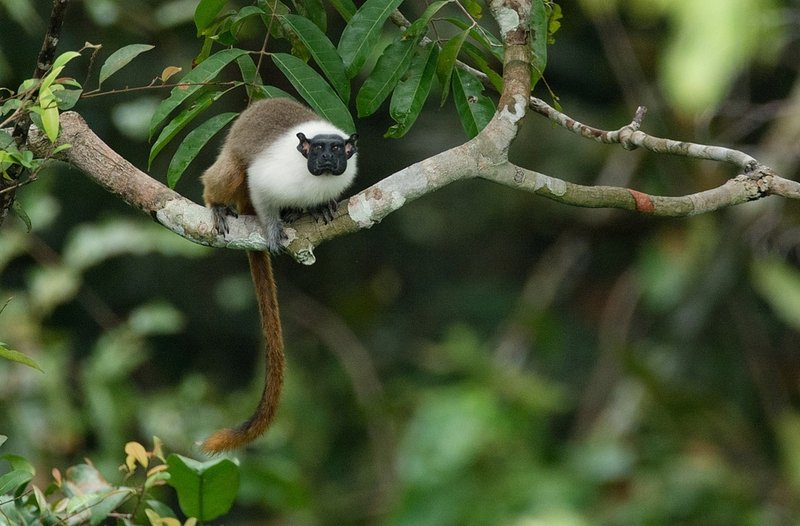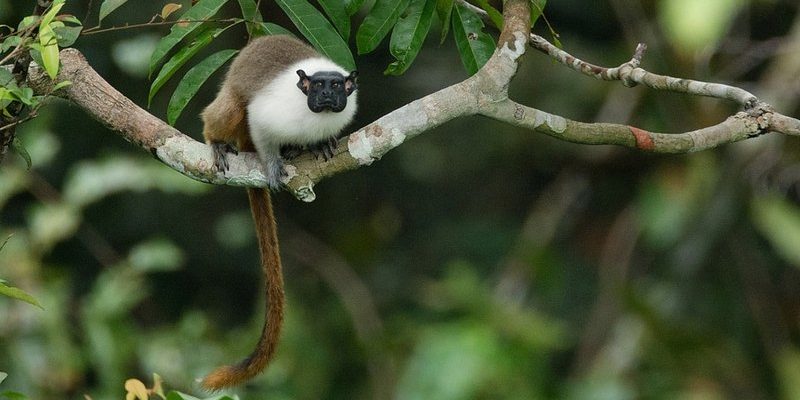
Tamarins are small, intriguing primates that inhabit the lush canopies of South American rainforests. With their charming faces and lively personalities, they are often considered some of the most captivating members of the monkey family. Think of them as the clowns of the jungle, swinging through branches and playing with one another, drawing smiles from anyone lucky enough to catch a glimpse.
These tiny creatures are known for their striking appearances, characterized by vibrant fur and expressive eyes. They come in several species, each with its unique colors and traits, but they all share a lively spirit that keeps them active and playful. Tamarins thrive in social groups, often seen cooperating and communicating in ways that hint at the complex relationships and hierarchies within their communities.
In this article, we’ll explore everything you need to know about tamarins—from their habitats to their diets, and even some fun facts that make them truly special. So grab your favorite comfy seat, and let’s dive into the enchanting world of tamarins!
What are Tamarins?
Tamarins belong to the family Callitrichidae and are part of the larger group of New World monkeys. If you’re picturing tiny, fluffy creatures with oversized eyes, you’re not far off! These small primates generally weigh between 0.5 to 1.5 kilograms and measure about 20 to 30 centimeters long. They have a distinctive look with tufted ears and a long tail that helps them balance as they leap and swing through the trees.
There are several species of tamarins, including the golden lion tamarin, the cotton-top tamarin, and the emperor tamarin. Each species showcases its unique traits, colors, and markings. For instance, the golden lion tamarin is known for its stunning golden fur, giving it a lion-like appearance, while the emperor tamarin boasts a striking white mustache that adds to its distinctive charm.
In addition to their beautiful looks, tamarins are social animals. They live in family groups, often consisting of up to 15 members. These groups work together to find food, raise young, and keep watch for predators. Tamarins communicate using a range of vocalizations, including whistles and chirps, making their social interactions fascinating to observe.
Habitat and Distribution
Tamarins primarily inhabit tropical rainforests, where they make their home among the tall trees. They are typically found in the dense canopies, where they feel safe from ground predators. Many species prefer the lowland rainforests of the Amazon Basin, while others can be spotted in the Atlantic Forests along Brazil’s coast.
Their choice of habitat isn’t just about safety; it also provides a rich source of food. Tamarins are arboreal, meaning they spend most of their lives in trees. They leap and climb from branch to branch, using their agile bodies to navigate the intricate networks of the forest. Their diet mainly consists of fruits, insects, and small vertebrates, making them omnivorous creatures that enjoy a varied menu.
Unfortunately, habitat destruction due to logging, agriculture, and urban development poses a significant threat to tamarins. Many species are now considered endangered as their natural homes shrink. Conservation efforts are underway to protect these enchanting primates and their rich rainforest habitats, ensuring they can continue to thrive for future generations.
Diet and Feeding Behavior
Just like you might enjoy a colorful fruit salad, tamarins love to munch on a variety of foods! Their diet mainly consists of fruits, insects, and small animals, making them omnivorous. They have a special fondness for fruits like figs and berries, which offer plenty of the sugars they need for energy during their bustling day of play.
Tamarins also enjoy munching on insects, which provide the protein necessary for their growth and health. You might see them eagerly foraging among the leaves and branches, expertly using their sharp claws to peel back bark or uncover hidden treasure like beetles and ants. This hunting for insects shows how adaptable these little creatures can be within their habitats.
Interestingly, tamarins have a social feeding behavior. They often share food with one another, especially within their family groups. This sharing not only strengthens their bonds but also enhances the group’s overall survival, as more eyes can spot food sources and potential dangers. It’s a lovely example of teamwork in the wild!
Social Structure and Behavior
Imagine living in a household where everyone pitches in and looks out for one another—that’s essentially how tamarin families operate! Tamarins are highly social creatures and typically live in cohesive family units. These groups usually include a breeding pair and their offspring, along with other relatives, creating a tight-knit community.
Within these groups, you’ll find a clear hierarchy. The dominant pair usually leads the group and takes charge of breeding, while other members help care for the young. This system of cooperation is crucial as it allows the group to raise several offspring simultaneously, increasing their chances of survival in the wild. What’s fascinating is that all adults in the group participate in rearing the young, demonstrating how supportive these family bonds can be.
Tamarins communicate through various vocalizations, body language, and physical interactions. They often use high-pitched calls to alert others of potential danger or to coordinate their movements while foraging. Grooming is another important aspect of their social life, serving as a way to strengthen bonds and maintain hygiene. Imagine it as their version of a friendly chat while keeping each other looking sharp!
Reproduction and Lifespan
When it comes to reproduction, tamarins have some unique traits. Typically, the dominant female in a family group will mate with the dominant male, leading to a gestation period that lasts about 140 to 150 days. After this period, the female gives birth to twins, which are relatively common in tamarin litters. Isn’t that adorable? These tiny twins are usually born blind and helpless, relying on their parents and other group members for care and protection.
After they’re born, tamarin babies are quite the responsibility. The other family members take turns carrying the little ones, giving the mother a much-needed break. This shared care not only ensures the babies receive constant attention but also allows them to bond with their relatives. It’s a wonderful example of how teamwork extends beyond just foraging for food!
Fun Facts About Tamarins
Ready for some fun insights into the world of tamarins? Here are a few intriguing tidbits:
- Golden Lion Tamarin: This species was brought back from the brink of extinction thanks to concerted conservation efforts.
- Social Grooming: Grooming is essential not only for hygiene but also for developing and maintaining social bonds.
- Impressive Agility: Tamarins can leap up to 15 feet between trees—a true testament to their agility!
- Distinctive Calls: Each tamarin group has its unique set of calls and chirps, making communication among them quite fascinating.
- Variety of Species: There are several species of tamarins, including the emperor, cotton-top, and golden lion tamarins, each with their own unique traits.
Conservation Status
Sadly, tamarins face significant challenges due to habitat loss and fragmentation. Deforestation, agricultural expansion, and urban development have all taken a toll on their populations. Many species are now listed as endangered or vulnerable, highlighting the urgent need for conservation efforts. Protecting their habitats is crucial not only for their survival but also for maintaining the biodiversity of our planet.
Conservation programs aim to restore and safeguard the natural habitats of tamarins. This includes creating protected areas and promoting sustainable practices that minimize human impact on the environment. Local communities are often involved in these efforts, raising awareness about the importance of preserving these incredible primates and their rainforest homes.
Every little bit counts! By supporting wildlife conservation organizations, spreading awareness, and encouraging responsible land-use practices, we can all play a part in ensuring that tamarins continue to thrive in their natural environments. Together, we can make a difference for these charming little primates.
FAQ
Are tamarins dangerous to humans?
No, tamarins are not dangerous to humans. They are generally shy and non-aggressive. In the wild, they would rather avoid human interaction. Tamarins are small and primarily focused on foraging for food and socializing with their group members.
How do tamarins defend against predators?
Tamarins use their agility and speed to escape from predators. They are excellent climbers and can swiftly leap from branch to branch, making it difficult for predators like birds of prey or snakes to catch them. They also rely on their social structure, alerting one another of potential threats using vocalizations.
Can tamarins be kept as pets?
While tamarins may seem like cute pets, they are wild animals that require specific care, social interaction, and a natural habitat. Keeping them as pets is not advisable and often illegal in many places. They thrive in social groups and need ample space to roam, which is difficult to replicate in a home setting.
What do tamarins communicate about?
Tamarins communicate about various aspects of their lives, including locating food, warning of dangers, and coordinating movements while foraging. Different vocalizations signal different messages; for example, a specific call might indicate the presence of a predator, while another could be used for group cohesion.
Do tamarins have a specific breeding season?
Tamarins do not have a fixed breeding season; they can mate year-round. However, environmental factors such as food availability may influence their reproductive patterns. This flexibility allows them to adapt to changing conditions in their habitats.
How many offspring do tamarins usually have?
Tamarins often give birth to twins, making it common for a single pregnancy to yield two babies. This is particularly advantageous as it increases the number of young that can survive, especially with the help of the entire family group participating in rearing them.
Are all tamarin species endangered?
Not all tamarin species are endangered, but many are facing threats due to habitat loss and other human activities. For example, the golden lion tamarin has made a recovery thanks to conservation efforts, while others, like the cotton-top tamarin, are critically endangered and require ongoing protection.
How can I help tamarins in the wild?
You can help tamarins by supporting wildlife conservation organizations that focus on rainforest preservation and tamarin protection. Raising awareness about the importance of biodiversity and advocating for sustainable practices in your community also contributes to their conservation.
What is the social structure of a tamarin group like?
Tamarin groups are typically led by a dominant breeding pair, with other members being their offspring and relatives. This social structure fosters cooperation in carrying and caring for young and increases the group’s chances of survival through shared responsibilities.
What is the role of grooming in tamarin social interactions?
Grooming among tamarins serves multiple purposes: it helps maintain hygiene and strengthens social bonds between members of the group. Through grooming, they reinforce relationships, calm each other, and ensure their fur is free of parasites, contributing to overall health.
How do tamarins adapt to their environment?
Tamarins are highly adaptable creatures. They thrive in various rainforest environments and adjust their foraging strategies based on food availability. Their agility allows them to maneuver through the trees efficiently, helping them escape predators and find food in their dynamic habitats.
What do tamarins eat besides fruit?
In addition to fruits, tamarins consume a range of insects and small vertebrates. Their omnivorous diet is crucial for their growth and health, providing the necessary nutrients to support their active lifestyles. Foraging for insects is a significant part of their daily activities.

